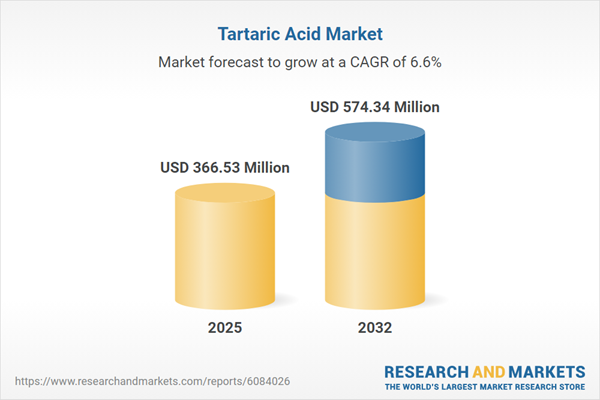Speak directly to the analyst to clarify any post sales queries you may have.
The tartaric acid market stands at a pivotal juncture, advancing on the strength of its diversified applications across food, pharmaceutical, cosmetics, and industrial sectors. Senior decision-makers require a comprehensive view of this evolving landscape to drive growth, anticipate regulatory shifts, and successfully manage supply chain complexities.
Market Snapshot: Tartaric Acid Market Growth and Industry Drivers
The tartaric acid market is experiencing steady expansion, with market value increasing from USD 343.93 million in 2024 to USD 366.53 million in 2025. It is forecasted to reach USD 574.34 million by 2032, representing a compound annual growth rate of 6.61%. This upward trajectory is powered by shifting consumer demand favoring clean-label ingredients, a global move towards process innovation, and the industry’s firm focus on responsible, sustainable sourcing. Producers are leveraging enhanced manufacturing efficiencies and diversifying their raw material base, contributing to improved supply stability and market resilience.
Scope & Segmentation: Comprehensive Market Coverage
- Purity Grade: Food grade, technical grade, and USP grade options offer tailored solutions for different end uses including food processing, pharmaceuticals, and varied industrial applications.
- Form: Available in both crystalline and powder formats, tartaric acid meets requirements for diverse manufacturing preferences—ranging from applications that require rapid dissolution to those needing stable, solid formulations.
- Production Process: The market supports both natural extraction techniques and scalable synthetic production methods, ensuring consistency even when supply of raw materials fluctuates due to seasonal or global sourcing factors.
- Application: Utilized across a broad spectrum, including food and beverage (with emphasis on bakery, confectionery, dairy, soft drinks, and wine), cosmetics, industrial uses such as metal and textile processing, and pharmaceuticals.
- Distribution Channel: The sector employs both offline and online distribution models, enabling broad global accessibility. Digital procurement is increasingly important for new entrants seeking efficient and transparent sourcing.
- Regional Coverage: Coverage spans the Americas (including both North America and Latin America), EMEA (European, Middle Eastern, and African key economies), and Asia-Pacific. Each region offers unique advantages, from supply chain capacity to regulatory environment.
- Company Coverage: Industry analysis features key players such as Avantor Inc., Caviro Extra S.p.A., Central Drug House (P) Ltd., Sip Chemical Industries, Spectrum Chemical Mfg. Corp., Thermo Fisher Scientific Inc., Tokyo Chemical Industry Co., Ltd., Foodchem International Corporation, Industrias Vinicas S.A., and Merck KGaA.
Key Takeaways: Strategic Insights for Decision-Makers
- Expanding Use Cases: Tartaric acid’s role as an acidulant, antioxidant, and chelating agent is driving increased incorporation into food quality improvement, preservation, and high-performance industrial formulations.
- Process Innovations: Advances in automation, data-driven quality monitoring, reactive crystallization, and membrane separation are streamlining production while maintaining product quality and safety standards.
- Adaptive Sourcing Models: Producers balance the use of natural byproducts—such as those from wine production—with synthetic processes to buffer against seasonal variations and regulatory challenges, maintaining consistent supply.
- Regional Adaptation: Americas invest in domestic capacity and nearshoring to counter trade disruptions, EMEA leverages historical expertise in wine-based tartaric acid production, while Asia-Pacific capitalizes on rapid expansion in beverage and dairy markets.
- Focus on Sustainability and Digitalization: Leading firms advance circular economy initiatives, integrating environmentally responsible practices while implementing digital solutions to enhance procurement transparency and operational efficiency.
- Targeted Product Segmentation: Accurately aligning purity grades and form factors with specific customer and regulatory requirements is vital for sustained competitiveness and compliance in target markets.
Tariff Impact: Responding to Trade Policy Shifts
The introduction of U.S. trade tariffs in 2025 recalibrated tartaric acid import patterns and input costs. North American producers are proactively responding through stable supply agreements, expanding partnerships close to home, and optimizing pricing strategies to strengthen market position and offset ongoing volatility.
Methodology & Data Sources
Research for this report is based on a hybrid approach, integrating direct interviews with sector executives, regulatory authorities, and supply chain specialists. This is augmented with secondary analysis from scientific publications, trade databases, and proprietary datasets. Comprehensive data triangulation and scenario modeling underpin the accuracy and relevance of all findings.
Why This Report Matters
- Provides decision-makers with actionable intelligence by contextualizing growth potential, regulatory developments, and the impacts of technological advancements in the tartaric acid market.
- Enables strategic planning for diversification, procurement optimization, and resilience in the face of shifting global trade environments.
- Supports operational execution for manufacturers and suppliers aiming for compliance, efficiency, and innovation in highly regulated and competitive sectors.
Conclusion
The tartaric acid market delivers multiple avenues for growth, built upon advances in technology, supply strategies, and application diversity. Strategic alignment with evolving market realities empowers stakeholders to compete effectively and navigate sector-specific challenges with confidence.
Table of Contents
3. Executive Summary
4. Market Overview
7. Cumulative Impact of Artificial Intelligence 2025
Companies Mentioned
The companies profiled in this Tartaric Acid market report include:- Avantor Inc.
- Caviro Extra S.p.A.
- Central Drug House (P) Ltd.
- Sip Chemical Industries
- Spectrum Chemical Mfg. Corp.
- Thermo Fisher Scientific Inc.
- Tokyo Chemical Industry Co., Ltd.
- Foodchem International Corporation
- Industrias Vinicas S.A.
- Merck KGaA
Table Information
| Report Attribute | Details |
|---|---|
| No. of Pages | 187 |
| Published | November 2025 |
| Forecast Period | 2025 - 2032 |
| Estimated Market Value ( USD | $ 366.53 Million |
| Forecasted Market Value ( USD | $ 574.34 Million |
| Compound Annual Growth Rate | 6.6% |
| Regions Covered | Global |
| No. of Companies Mentioned | 11 |









